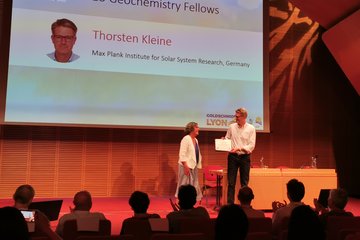Alle Typen
1.
Zeitschriftenartikel
Properties of structured coronal mass ejections in solar cycle 23. Advances in Space Research 38 (3), S. 461 - 465 (2006)
2.
Zeitschriftenartikel
Understanding interplanetary coronal mass ejection signatures. Space Science Reviews 123 (1-3), S. 177 - 216 (2006)
3.
Zeitschriftenartikel
Properties and geoeffectiveness of magnetic clouds in the rising, maximum and early declining phases of solar cycle 23. Annales Geophysicae 23 (2), S. 625 - 641 (2005)
4.
Zeitschriftenartikel
Solar origins of intense geomagnetic storms in 2002 as seen by the CORONAS-F satellite. Advances in Space Research 36 (8), S. 1595 - 1603 (2005)
5.
Zeitschriftenartikel
The solar and interplanetary causes of space storms in solar cycle 23. IEEE Trans. Plasma Sci. 32 (4), S. 1411 - 1414 (2004)
6.
Zeitschriftenartikel
On the three-dimensional configuration of coronal mass ejections. Astronomy and Astrophysics 422, S. 307 - 322 (2004)
7.
Zeitschriftenartikel
The basic characteristics of EUV post-eruptive arcades and their role as tracers of coronal mass ejection source regions. Astronomy and Astrophysics 422 (1), S. 337 - 349 (2004)
8.
Zeitschriftenartikel
Properties of slow magnetic clouds. Journal of Atmospheric and Solar-Terrestrial Physics 66 (2), S. 147 - 151 (2004)
9.
Zeitschriftenartikel
Solar and heliospheric phenomena in October-November 2003: Causes and effects. Cosmic Research 42 (5), S. 435 - 488 (2004)
10.
Zeitschriftenartikel
Identification of solar sources of major geomagnetic storms between 1996 and 2000. Astrophysical Journal 582 (1), S. 520 - 533 (2003)
11.
Zeitschriftenartikel
Solar and heliospheric causes of geomagnetic perturbations during the growth phase of solar cycle 23. Solar System Research 36 (6), S. 499 - 506 (2002)
12.
Zeitschriftenartikel
Field draping around an interplanetary magnetic cloud with a shock wave. Geomagn. Aeron. 42 (4), S. 425 - 429 (2002)
13.
Zeitschriftenartikel
Eruptive prominences as sources of magnetic clouds in the solar wind. Space Science Reviews 70, S. 215 - 220 (1994)
14.
Konferenzband
Physics and Chemistry of the Earth, II. Space Weather. Elsevier Science Ltd. (2001)
15.
Konferenzbeitrag
SOHO/EIT observation of a coronal inflow. In: Coronal and Stellar Mass Ejections, Proc. IAU Symp. 226, S. 133 - 134 (Hg. Dere, K. P.; Wang, J.; Yan, Y.). Cambridge University Press, Cambridge (2005)
16.
Konferenzbeitrag
MAGRITTE: an instrument suite for the solar atmospheric imaging assembly (AIA) aboard the Solar Dynamics Observatory. In: Telescopes and Instrumentation for Solar Astrophysics, S. 53 - 64 (Hg. Fineschi, S.; Gummin, M.). SPIE - International Society for Optical Engineering (2004)
17.
Konferenzbeitrag
Plasma dynamics of a prominence associated coronal mass ejection. In: Multi-Wavelength Investigations of Solar Activity, Proc. IAU Symp. 223, S. 401 - 402 (Hg. Stepanov, A. V.; Benevolenskaya, E. E.; Kosovichev, A. G.). University Press, Cambridge (2004)
18.
Konferenzbeitrag
Solar Wind Disturbances and Their Sources in the EUV Solar Corona. In: Solar Wind Ten: Proceedings of the Tenth International Solar Wind Conference, S. 711 - 714 (Hg. Velli, M.; Bruno, R.; Malara, F.). American Institute of Physics (2003)
19.
Konferenzbeitrag
Comparison of CMEs, magnetic clouds, and bidirectionally streaming proton events in the heliosphere using HELIOS data. Advances in Space Research, S. (9)71 - (9)74 (1993)
20.
Konferenzbeitrag
Magnetic cloud observations by the Helios spacecraft. In: Solar Wind Seven, COSPAR Colloquia Series Volume 3, S. 599 - 602 (Hg. Marsch, E.; Schwenn, R.). Pergamon Press, Oxford, New York, Seoul, Tokyo (1992)











